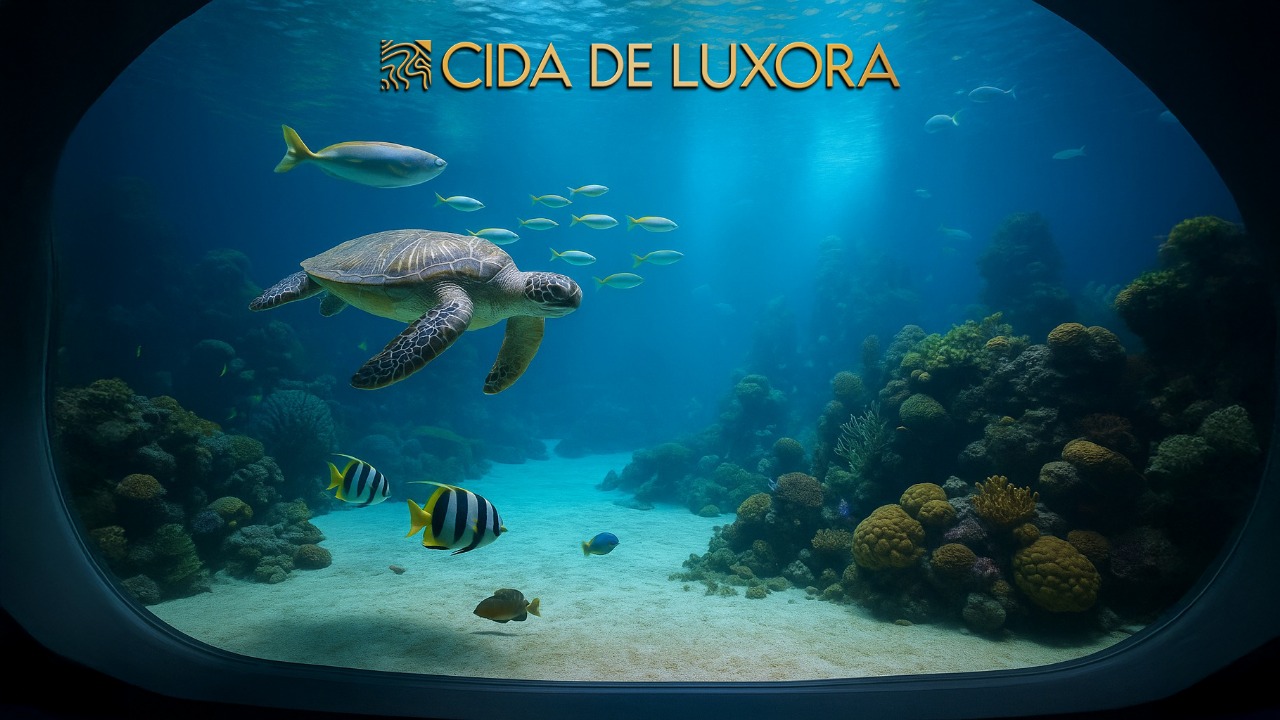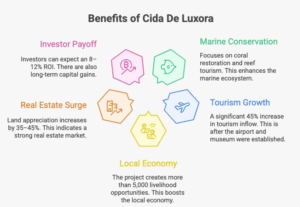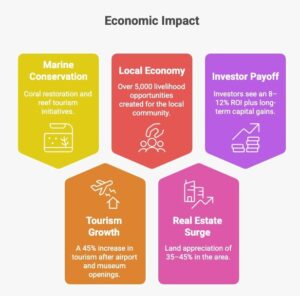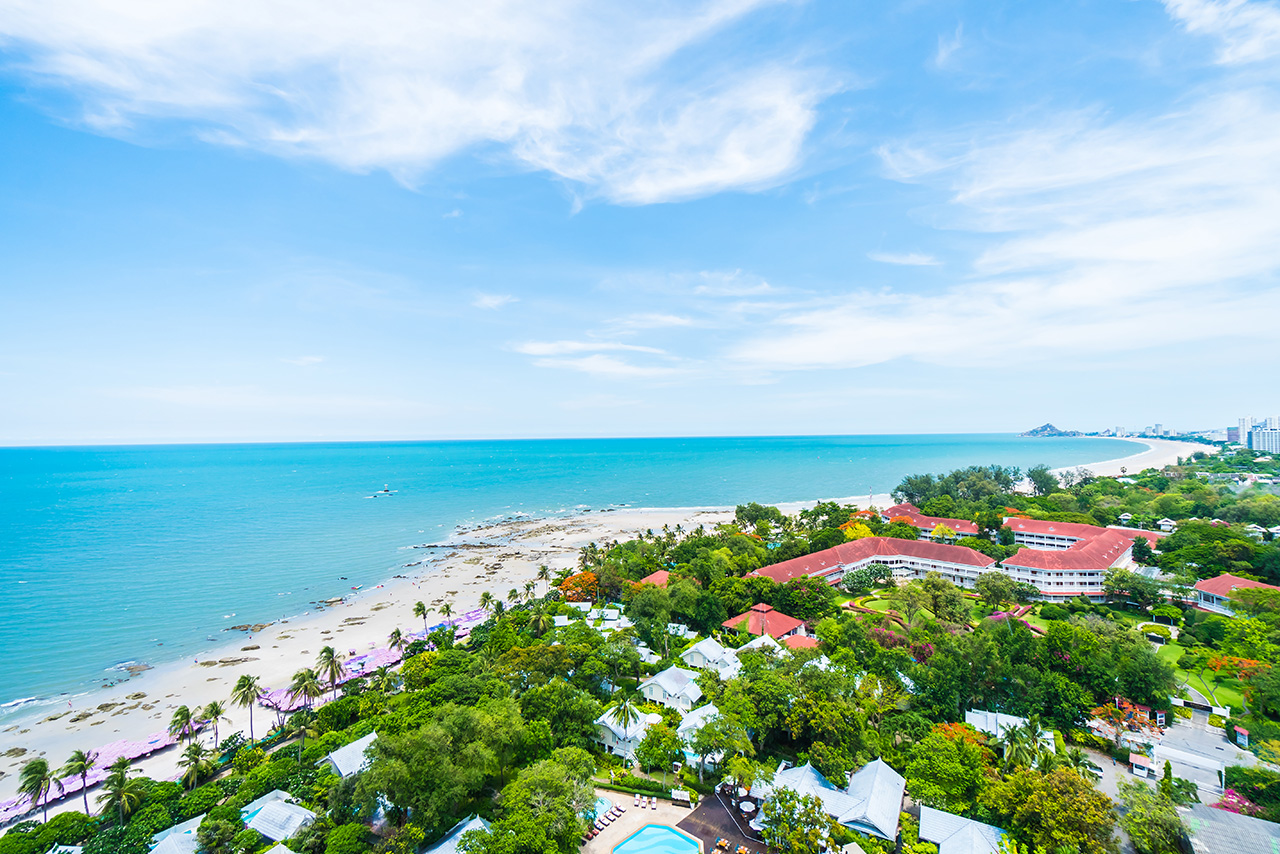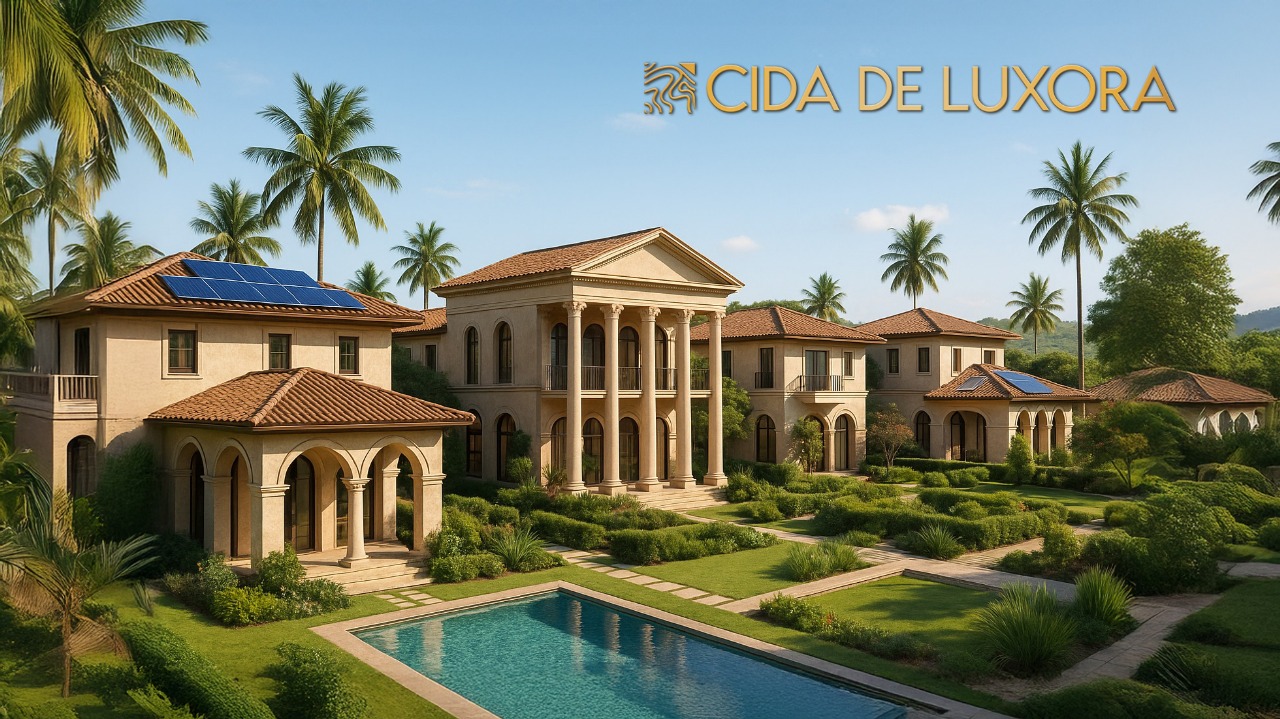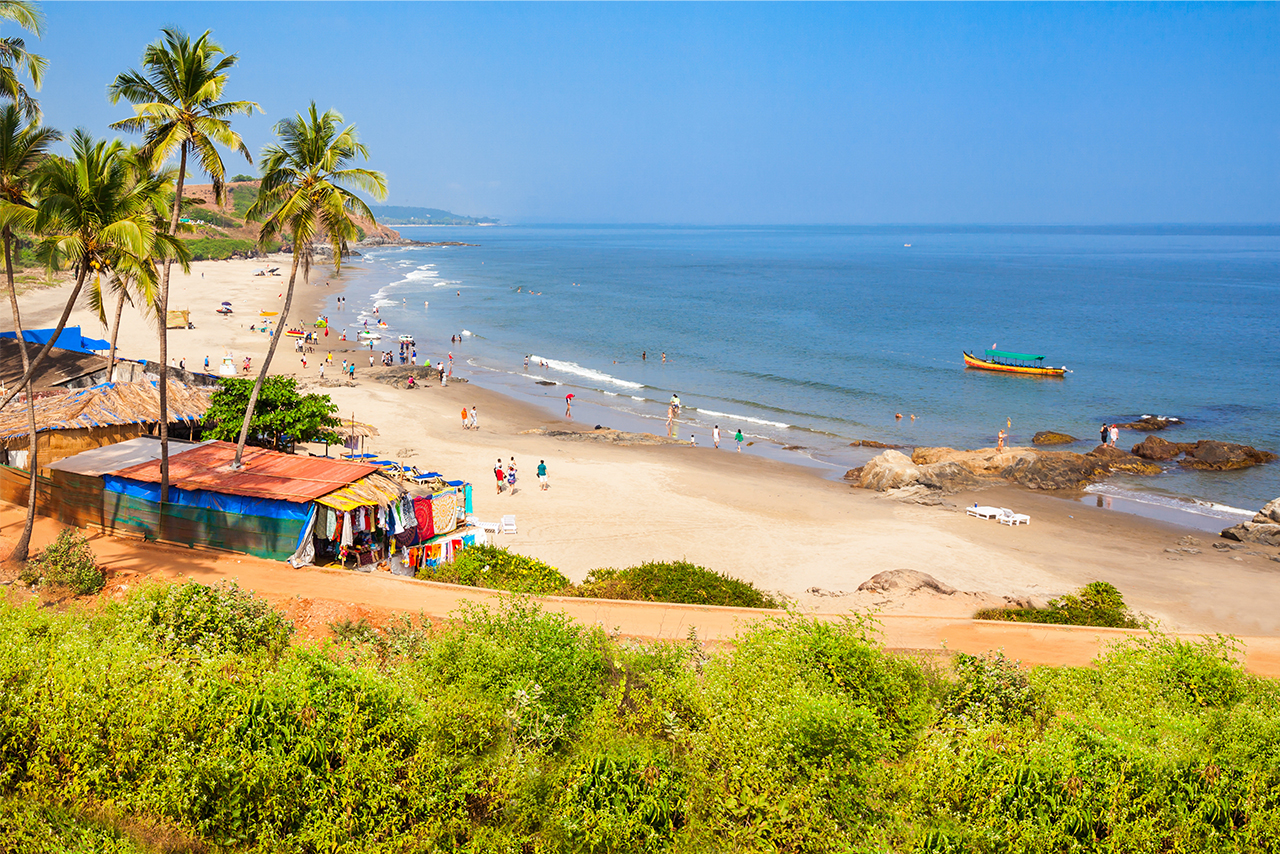Table of Contents
ToggleUnderwater Museum in Sindhudurg: How a ₹46.91 Cr Reef Project Could Make Maha-Goa India’s Next Marine Tourism Icon by 2026
Why the Underwater Museum in Sindhudurg Is More Than a Tourist Magnet
Picture yourself descending into a clear blue world where coral gardens frame a gallery of sculptures, each piece telling a story of coastal heritage. This isn’t the Maldives. This is India’s own Underwater Museum in Sindhudurg, a ₹46.91 crore reef project designed to restore marine life, attract global divers, and — crucially — flip the investment script for the Maha-Goa belt. When tourism infrastructure is this experiential, property values don’t just climb — they compound. Airports, highways, ferries, and now a living museum beneath the sea: the demand drivers are stacking, and early movers have the current in their favour.
In one line: If you’ve been searching for the next North Goa, the Underwater Museum in Sindhudurg is the anchor that turns curiosity into conviction.
What exactly is the Underwater Museum in Sindhudurg? Scope, Spend, and Strategy
The Underwater Museum in Sindhudurg is a first-of-its-kind living reef attraction located off the Sindhudurg coast near Vengurla. Built under eco-tourism guidelines and aligned with national initiatives like Swadesh Darshan 2.0, the project blends:
- Artificial reef modules and curated sculpture trails to accelerate coral growth and biodiversity.
- Guided scuba and snorkelling experiences with strict carrying-capacity controls.
- Training and livelihood creation for local communities via dive centres, safety crews, and interpretive guides.
- Continuous monitoring of water clarity, reef health, and visitor impact, so the Underwater Museum in Sindhudurg remains both a conservation asset and a premium attraction.
- Integrations with shoreline interpretation centres that explain local fisheries, mangroves, and turtle conservation, helping visitors connect surface ecosystems with the world below.
Why it matters: Marine attractions have a multiplicative effect. Each certified diver spends more, stays longer, and returns with groups. That spend circulates into F&B, boutique retail, wellness, and upscale stays — the exact ecosystem the Maha-Goa corridor is now building.
Timeline & Milestones: From Vision to Visitation
- Concept & Feasibility: Reef-suitability surveys, current mapping, water-clarity baselines, and ecological carrying capacity studies conducted with academic partners and dive experts.
- Design Development: Selection of reef-safe materials, sculpture geometry optimised for coral settlement, and deployment patterns designed to channel divers without disturbing juvenile reefs.
- Permits & Protocols: Coastal regulation, maritime safety, and tourism standards cleared in phased manner; integration with lifeguard and emergency response systems.
- Phase-1 Deployment: Initial sculpture park installation and monitoring buoys placed; diver routes marked; mooring to prevent anchor damage.
- Community Onboarding: Local youth trained as dive masters, safety crew, and eco-docents; women’s SHGs onboarded for gear maintenance and hospitality add-ons.
- Soft Opening: Limited-ticketed immersions under strict capacity management to build reviews and refine SOPs.
This staged approach ensures the Underwater Museum in Sindhudurg launches safely, builds credibility early, and keeps ecological integrity at the core.
The Demand Stack: Four Big Triggers Behind Sindhudurg’s Upswing
- Air Access — MOPA + Chipi: With Manohar International Airport (MOPA) enabling long-haul arrivals and Chipi (Sindhudurg) catalysing regional connectivity, the funnel for premium coastal tourism has widened. Add the Underwater Museum in Sindhudurg and you’ve got a signature reason to extend itineraries beyond Goa’s usual grid.
- NH-66 Expansion: Highway improvements reduce friction for self-drive travellers and logistics. Projects that sit 2 minutes from NH-66, like Cida De Luxora, convert accessibility into absorption.
- Ferry & Ro-Ro Links: Mumbai–Konkan sea routes compress travel time and inject weekend traffic.
- High-Value Experiences: Scuba, shipwreck tours, reef trails, and coastal heritage circuits mean visitors seek boutique stays and villa-style comfort — a perfect match for luxury villa plots in Maha-Goa developed by trusted names.
Result: An experience such as the Underwater Museum in Sindhudurg doesn’t just increase arrivals; it upgrades the customer mix — NRIs, HNIs, creators, wellness travellers — precisely the profiles that power rental yields and branded retail.
Comparative Lens: What Global Underwater Museums Teach Us
From Mexico’s MUSA to Europe’s underwater sculpture parks in Cyprus and Cannes, the pattern is consistent:
- Place Branding: The attraction becomes synonymous with the destination; social media turns divers into ambassadors.
- Yield Uplift: Proximity premiums develop for stays with concierge and privacy — villas outperform generic hotel rooms.
- Sustainability Halo: Destinations that tie art with reef restoration enjoy better global press and longer visitor attention spans.
- Local Livelihoods: Dive training, boat operations, and crafts expand the economic pie.
The Underwater Museum in Sindhudurg is engineered on similar principles, giving Maha-Goa a world-class differentiator while keeping ecological health centre stage.
From Tourism to Tangible Returns: How Marine Attractions Move Real Estate
Across global coastal cities, dive-led tourism correlates with persistent price premiums in nearby micro-markets. The mechanics are straightforward:
- Length of Stay ↑ → Nightly ADR ↑ → Absorption of luxury inventory ↑
- Experience Scarcity: Only a handful of destinations worldwide offer an underwater museum; scarcity supports long-run pricing.
- Year-Round Calendar: Reef sites distribute visits beyond peak party seasons, stabilising occupancy and smoothing cash flow.
- Place Identity: The Underwater Museum in Sindhudurg gives Maha-Goa a distinct brand — not a spillover of Goa, but a specialised eco-luxury coast.
For investors, this translates to dual income (holiday rental + appreciation). With organised operators and concierge models emerging, villa management is becoming plug-and-earn.
Micro-Market Map: The Golden Hour Radius
- 15–20 Minutes: Vengurla, Shiroda — white-sand beaches, calm coves for snorkelling, emerging café culture.
- 25–35 Minutes: Querim (Keri), Arambol fringe — overflow from North Goa’s experiential travellers seeking quieter stays.
- 40–50 Minutes: Candolim/Calangute/Baga belt — day-trip access without the noise premium; excellent for cross-marketing.
- 10 Minutes Inland: Sawantwadi Railway Station and town amenities; staff and supplies flow predictably.
Within this radius, CDL’s plots combine coastal access with highway certainty — a rare pairing in coastal investments.
Cida De Luxora: Roman Grandeur, Coastal Logic
Cida De Luxora is the Maha-Goa belt’s signature live-work-earn ecosystem: villa plots, luxury retail, and highway-facing offices inside a gated, Roman-inspired enclave curated by Nine Divine Group. Strategically placed near Sawantwadi on SH-180 and 2 minutes from NH-66, it sits within a short coastal hop of Vengurla’s white sands — and the Underwater Museum in Sindhudurg.
Why CDL is aligned with the museum’s rise:
- Demand Matching: Reef-led tourism attracts travellers who prefer private pools, kitchens, and concierge — exactly the format a custom villa provides.
- Retail Uptake: Dive cafés, wellness studios, artisanal boutiques, and gear outlets thrive on steady footfall.
- Office Logic: Remote founders, creators, and consultants need branded addresses and small suites — CDL’s offices are designed for that niche.
- Security & Prestige: 24/7 surveillance, access control, and clubhouse privileges deliver the quiet luxury that this audience seeks.
- Sustainable Edge: Landscaped gardens, walking trails, and smart-home readiness align with eco-conscious travellers.
Numbers Investors Care About: Scenarios, Benchmarks, Signals
Rental Yield Pointers
- Boutique villa rentals near reef or dive zones globally post 8–12% gross yields with professional management.
- In the Maha-Goa micro-market, seasonality is being flattened by experiential travel; expect higher weekend ADRs and sustained shoulder-season demand.
Appreciation Signals
- New-to-India attractions like the Underwater Museum in Sindhudurg create identity premiums.
- Highway-proximate, airport-synergistic assets historically outperformed broader coastal averages.
Scenario Sketch (illustrative)
- 600 sq yd custom villa with pool and 3 ensuite bedrooms.
- 140–160 occupiable nights at blended ADR; 55–60% annual occupancy achievable in year 2 with proper channel management.
- Net yield after OPEX and management in the 6–9% band; appreciation kicker is additive.
Risk Filters & Mitigation
- Over-commercialisation → choose gated, low-density communities.
- Compliance → project with clear title, bank funding, and approvals (CDL aligns).
- Climate resilience → elevation, drainage, storm-water systems, and material specs.
Connectivity That Converts Browsers into Buyers
- MOPA International Airport: ~30–45 mins from Sawantwadi belt depending on sector.
- Chipi (Sindhudurg) Airport: ~40 mins, turbo-boosting regional traffic.
- NH-66 & SH-180: CDL is bang on SH-180 and 2 minutes from NH-66 — meaning drive-to convenience for Pune–Mumbai catchments.
- Sawantwadi Railway: ~10 mins; useful for staff mobility and budget travellers.
- Vengurla / Shiroda / Querim Beaches: 15–35 mins; Underwater Museum in Sindhudurg sits within this coastal radius.
Connectivity reduces friction; frictionless destinations absorb capital faster.
Sustainability: When a Museum Is Also a Reef
The genius of the Underwater Museum in Sindhudurg is that it’s both art and ecology. Artificial reefs provide substrate for coral polyps; sculptures become micro-habitats; controlled visitation funds monitoring. For communities, that means skilled jobs, ocean literacy, and year-round pride. For investors, it means the demand base is mission-aligned: travellers pay a premium to stay, dive, and contribute.
Citizen Science & Storytelling
- QR-coded buoys and jetty signage can share live reef metrics (visibility, temperature, sightings).
- Partnerships with schools and creators to produce micro-documentaries; villas can host screenings as value-adds.
- Local art collectives can mirror underwater motifs in murals and ceramics, creating a cohesive destination aesthetic.
Blueprint for a Revenue-Ready Villa
- Architecture: Contemporary shell with Roman cues; shaded courtyards; cross-ventilation to cut AC loads.
- Spaces: 3–4 bedrooms, plunge or lap pool, outdoor shower, deck, kitchenette for chef-on-call.
- Ops Stack: PMS integration (Airbnb/Booking/VRBO), dynamic pricing, concierge upsells (dives, wellness, boat days).
- Branding: Name your villa; build an Instagram-ready identity; partner with dive operators for packages.
- Compliance: Trade licence, homestay norms, GST consult.
- Differentiators: Outdoor gear room for wetsuits, sand-friendly wash zone, drying racks, and a small camera-cleaning corner for underwater creators.
Tip: Aesthetics drive ADR. In a market shaped by the Underwater Museum in Sindhudurg, marine-inspired palettes, art, and sustainability stories create pricing power.
Buyer Personas: Who Wins Big Here?
- The Hybrid Investor: Lives part of the year, rents professionally the rest. Wants privacy, pool, concierge, and a strong digital brand.
- The Remote Founder/Creator: Needs a small office suite at CDL, high-speed connectivity, and a home studio. Cross-sells experiences to followers.
- The Eco-Luxury Family: Values reef experiences and sustainability; invests for legacy and usage value.
- The Land Banker: Allocates capital to serviced plots inside gated ecosystems with clear approvals to ride macro appreciation.
Each persona is naturally attracted by the story the Underwater Museum in Sindhudurg tells — discovery, conservation, and design-led living.
Legal & Regulatory Checklist: Peace of Mind Matters
- Title & Encumbrance: Verified; bank funding available.
- RERA & Local Approvals: Phased applications/registrations as per rollouts; documentation shared in data room.
- Society/Association Framework: Clear community by-laws for maintenance and rentals to preserve aesthetics and security.
- Insurance: Structure, contents, and third-party liability — particularly important for villas with pools and rental operations.
CDL’s structured approach reduces friction from purchase to possession, keeping focus on design and returns rather than paperwork.
Marketing Flywheel: From First Booking to Year-Round Calendar
- Channel Mix: Airbnb + Booking.com + direct website for repeat guests and lower commissions.
- Packages: “Dive & Dine” with partner operators; “Reef & Wellness” with spa and yoga add-ons at CDL’s clubhouse.
- Content: Underwater reels, conservation stories, and villa design details build an always-on narrative.
- Community: Engage with local festivals, beach clean-ups, and reef days to deepen roots and reviews.
The Underwater Museum in Sindhudurg provides seasonal hooks (new deployments, coral spawn windows, visibility peaks) that your brand calendar can revolve around.
Why Now Beats Later
- Edition Scarcity: CDL caps villas at 50 plots — scarcity is a moat.
- Construction Curve: Entering before full tourist maturity lets you capture both appreciation and the first-mover rental premium.
- Narrative Momentum: Airports operational, highway done, reef museum underway — the stack is live now.
Step-by-Step: From Site Visit to Keys in Hand
- Discovery Call: Outline your use case — end-use, hybrid, or pure investment.
- Data Pack: Layout, approvals, title diligence, and bank tie-ups shared.
- Site Visit: Airport pickup, Vengurla coastline drive-through, and CDL tour.
- Unit Selection: Choose plot orientation and frontage based on villa concept.
- Agreement & Funding: Bank partners available; stage-wise draws.
- Design & Build: Customisation (materials/finishes) with developer ecosystem.
- Go-Live: Management onboarding for rentals if desired.
FAQs
Q1. What is the Underwater Museum in Sindhudurg and how will it operate?
A. It’s a curated reef-art site combining marine conservation with tourism. Visitor numbers will be capped, guided by trained dive teams, with continuous monitoring to protect coral growth.
Q2. Where is it located in relation to Cida De Luxora?
A. Within the Vengurla–Shiroda coastal radius, a comfortable drive from CDL (Sawantwadi/SH-180). The Underwater Museum in Sindhudurg becomes a signature excursion for guests staying at CDL villas.
Q3. When is the museum expected to be visitor-ready?
A. The project is slated in the 2025–2026 window; phased access may begin earlier subject to conditions and permits.
Q4. What kind of tourists will this attract?
A. Certified divers, snorkellers, underwater photographers, eco-travelers, creators, and families seeking educational experiences.
Q5. How does this influence rental yields for villas?
A. Unique experiences increase length of stay and willingness to pay. With proper management, villas near the Underwater Museum in Sindhudurg can target mid-to-high single-digit net yields with appreciation upside.
Q6. Is the project environmentally safe?
A. The model uses artificial reef structures, low-impact materials, and strict carrying capacity, aligning tourism with conservation.
Q7. Why choose CDL over standalone plots?
A. Security, controlled aesthetics, clubhouse lifestyle, on-site retail, and highway-facing offices deliver a cohesive ecosystem — not just land.
Q8. Can NRIs invest in CDL?
A. Yes. Banks onboard provide funding options; the team facilitates documentation and closures.
Q9. What about maintenance and rental management?
A. CDL’s ecosystem supports concierge, housekeeping, and third-party rental operators to convert your villa into a revenue asset.
Q10. Who is behind Cida De Luxora?
A. The project is conceptualised and curated by Nine Divine Group, with bank tie-ups and government-compliant processes.
The first underwater museum doesn’t just give India a new dive site; it gives Maha-Goa a new destiny. With airports airborne, highways humming, and reef art rising, the stretch around Vengurla is moving from potential to proof. Align your capital where curiosity becomes calendar traffic — and where your villa can be both a family sanctuary and a cash-flowing asset.
Dive into Legacy — Not Just the Sea.
Book a private, concierge-curated site visit to Cida De Luxora. Walk the plots, tour the coastline, and preview your villa concept with our design team.
- Limited Edition: Only ~50 villa plots inside a gated Roman-inspired enclave.
- Location Edge: Bang on SH-180; 2 minutes from NH-66; a short coastal drive to the Underwater Museum in Sindhudurg.
- 3-in-1 Ecosystem: Villa plots + high-street retail + highway-facing offices.
- Trust: Government-compliant, bank-funded, curated by Nine Divine Group.
👉 Book Your Investment Presentation | Call/WhatsApp: ++91 98116 07999
